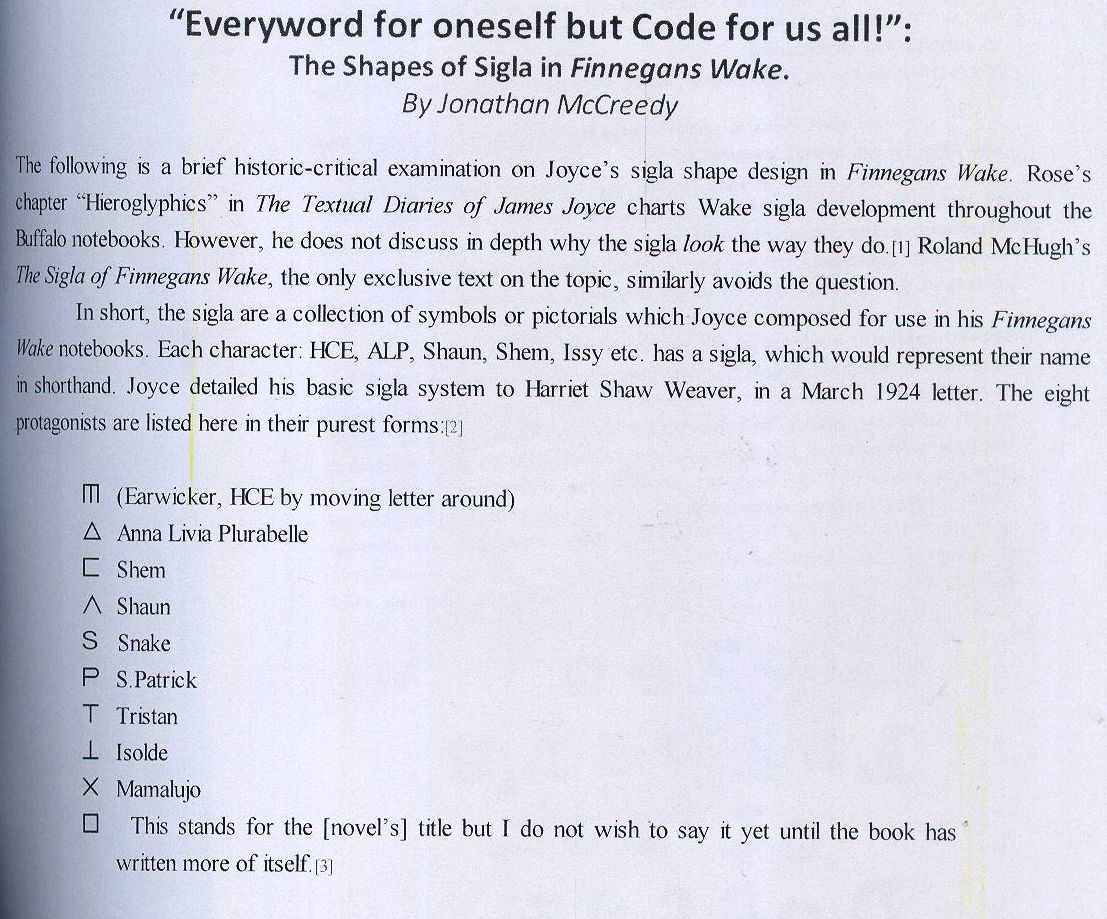HCE
The first appearence on the text (or the last if you are coming back by circling the last sentence with the first...) is when is mentioned Howth Castle and Environs (Howth Castle and surroundings)
As Jonathan Mcreedy puts it in his paper:
“Everyword
for oneself but Code for us all!”:
The Shapes of Sigla in Finnegans Wake.
By Jonathan McCreedy

(1) See Danis Rose, “Hieroglyphics”,
The Textual Diaries of James Joyce (Dublin: the Lilliput Press, 1995),
42-88.
(2) P does not appear in the notebooks, suggesting
that Joyce quickly dropped the concept. T evolved
into Shem as FW progressed.
(3) James Joyce, The Letters
of James Joyce, edited by Stuart Gilbert (London: Faber, 1957), 213.
This line of research to me does
not concurs to "seeing", as I already mentioned about Roland McHugh`s
The Sigla of Finnegans Wake, but taken on another perspective, i.e.,
as the possibility of grasp in one shot all the characters of Finnegans as Joyce
did, it is OK, and the perfect introduction to perhaps the main character of
the book. I would like to remind the reader that Ulysses is about only
three characters... To substantiate my opinion, I quote Prof.Atherton about
this "M" which stands for Earwicker, which is the same as HCE: (by
moving letter around, it turns mountain in chinese):
"He wrote to Miss Weaver that 'A Chinese student sent me some letterwords
I had asked for. The last one is![]() .It means "mountain" and is called "Chin", the common people's
way of pronouncing Hin or Fin." The sign used here is the one which Joyce
employed for H.C.E., but only another Chinese student could say what Joyce did
with the information he received. The word 'mountain' is used rather frequently
in the Wake in phrases such as 'a man that means a mountain' (309.4) or 'mightmountain
Penn' (19.32) and 'mountynotty man' (21.7). It seems probable that the word
'mountain' in the Wake is meant to include H.C.E. in its group of implications.
Probably Joyce wished to include in the Wake at least one specimen of every
language he could find. His readers can console themselves with the reflection
that the book is still written chiefly in English, with occasional additional
meanings from French, German and other European languages, while the proportion
of incomprehensible foreign words that may have been extracted from obscure
sacred books is very small. " page 170 James
S Atherton the Books at the Wake
.It means "mountain" and is called "Chin", the common people's
way of pronouncing Hin or Fin." The sign used here is the one which Joyce
employed for H.C.E., but only another Chinese student could say what Joyce did
with the information he received. The word 'mountain' is used rather frequently
in the Wake in phrases such as 'a man that means a mountain' (309.4) or 'mightmountain
Penn' (19.32) and 'mountynotty man' (21.7). It seems probable that the word
'mountain' in the Wake is meant to include H.C.E. in its group of implications.
Probably Joyce wished to include in the Wake at least one specimen of every
language he could find. His readers can console themselves with the reflection
that the book is still written chiefly in English, with occasional additional
meanings from French, German and other European languages, while the proportion
of incomprehensible foreign words that may have been extracted from obscure
sacred books is very small. " page 170 James
S Atherton the Books at the Wake
Another argument to substantiate
my opinion is that the square, which
stands for the novel,, has a most definite meaning which I explore glossing
the text as can it be seen there.
Since this file deals with HCE I will not dwell in the other symbols in a different
way Mr.Mcreedy did, but I will return to them when analysing other characters
as they show up in the text.
.